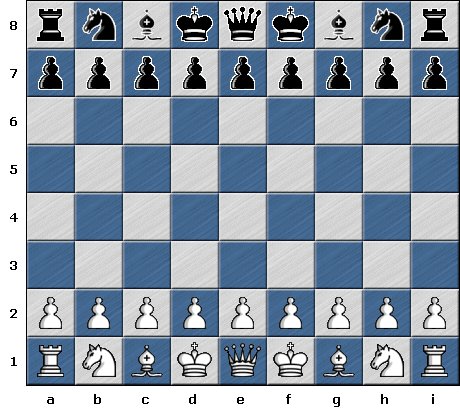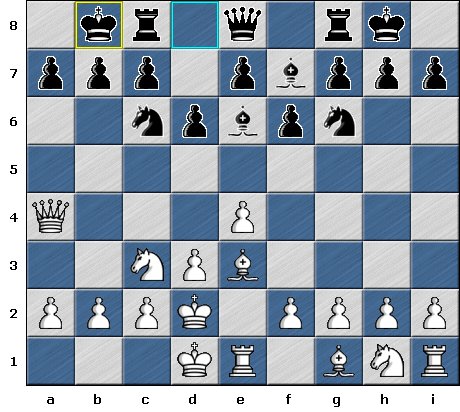| Pair of Kings |
| Pair of Kings is the first Cowplay variant to feature more than one king per player on a 9x8 board as shown in Figure 1. The odd board width (9 squares) also means that the bishops on both sides start on the same colored squares, but different for each side, giving each player a dominance on the given colored squares. |
| Pair of Kings Setup |
 |
| Figure 1 |
| Rules |
| Most of the standard chess rules apply to this variant, such as en-passant, pawn's 2-square advance and promotion. |
| Multiple Kings Rule |
This variant enforces the standard multiple kings rule. This rule states that if a player has more than one king they
cannot be placed in check. The implications for this rule mean that when a player has more than one king, any of that player's
kings may:
|
| Castling Variation |
|
This variant sees four potential castling moves per player - matching two kings with two rooks along the
bottom ranks. In all cases the king will always move two squares with the rook moving the rest of the way
onto the other side of the king.
For example, in the game shown in Figure 2, black has castled twice to both the leftside and the rightside of the board. However, white has decided to try to protect both kings together by castling his king oringally on f1 with the rook originally on a1, resulting in the king moving to d1 with the rook formally on a1 moving to e1. Note that white's king now on d2 started on d1 itself and was required to move out of the way to allow for this 'longer' castling move to take place. The PGN notation for the game in Figure 2 shown below is as follows: 1. d3 Ng6 2. Qb4 f6 3. Nc3 Bf7 4. e4 O-O 5. Be3 d6 6. Kd2 Bce6 7. O-O-O Nc6 8. Qa4 O-O-O * |
| Pair of Kings Castling |
 |
| Figure 2 |